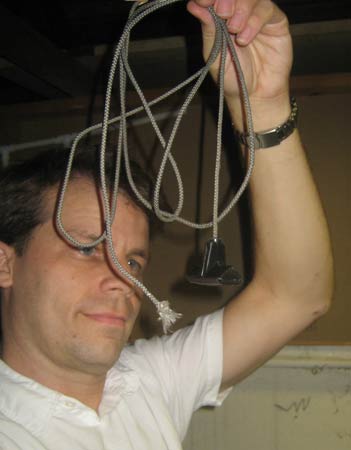


|
|

|
|
One time, when I was 10, I tried to fix an old lawnmower engine. I
wanted to attach it to the chassis of a homemade steel tube go-cart, and
race around the neighborhood.
I could not fix that lawnmower engine. However, I can fix a rewind starter pull cord. I've repaired a few of these, and the last time I attempted it, I took photos. Lawnmower pull cords break all the time. The cord gets wet, it sits in the sun, and it is subjected to a rough series of yanks every weekend in the summer. The cords are under a lot of stress. Some lawnmower cords end up as alcoholics. Others snap. Lawnmower cord breaks provide a short, fun repair project that will temporarily interrupt your lawn mowing duties.
Detailed instructions: I found 1/8th inch cotton cord at Home Depot. The bright yellow cord was the cheapest, so that is what I got. Steel guitar strings would never break, but they would probably rust. I think all of the bolts were 10mm. On some models of mower, the string pulley is attached to the inside of the metal housing. On others, it is attached to the shaft of the mower. I cut a nine-foot length of cord. I would trim the length later. The cord will need to be threaded into the starter pulley and fastened with a knot. To contain the frayed edge of the cord, I wrapped it with some electrical tape. Next, I wrapped the cord around the pulley two times. The pulley is spring-loaded. If you spin it with your hand, you should be able to feel recoil force building up. In an illustration on the right, I've shown the spring action as having the same effect as a stretched rubber band. Do not wrap the cord around this pulley by spinning it. You want the recoil springs to be relaxed when the loops of string are on there. Not all lawnmowers will need exactly two loops of string. You are trying to get one "pull's worth" of string loaded onto the pulley. The lawnmower in these photos used a pulley with a little channel around the outside, which was almost filled when the cord was wrapped around three times. You definitely want to avoid overfilling that channel with string, otherwise it might slip out of the channel, or rub against the outside housing. The end of the string then needs to be threaded through the hole in the pulley cover, on its way to the starter pull handle. Replace the pulley and cover, and fasten it with the bolts. Test the pull cord recoil. You want to make sure that the pulley rotates freely and has enough recoil to pull the cord back into the housing. Pull it a few times. I was impressed by how much more force I was able to use when the little black pull handle is on the end of the cord. If the recoil feels right, then put the gas tank back on. The starter handle was designed to sit at a convenient height on the mower handle. Ideally, the recoil spring keeps it ever-so-slightly drawn in towards the engine, so that the starter handle doesn't hang limply. On the mower I was fixing, A long metal staple held the handle on the string. I used a chisel to pry the staple out of the old, broken cord. I pulled the cord tight, and held it where I believed the handle would sit at a convenient height. A small metal loop was mounted on the mower handlebar. I threaded the starter cord through this too. I threaded the new cord into the handle and squeezed the staple into the new cord. Repair complete! You should now be able to utilize the rewind starter on your mower. Actually starting the thing will be another challenge altogether. My mower advertised "One Pull Start" which was technically true, it just ignored the 34 pulls before that one. |

|
|
Please continue reading page 2 of Easy, Illustrated Instructions on
How to replace the starter cord on a lawnmower. |
|
contact Rob
Science Club |
How much is inside? |
Home |
Incredible Stuff I Made | Pranks
|
March 2, 2007